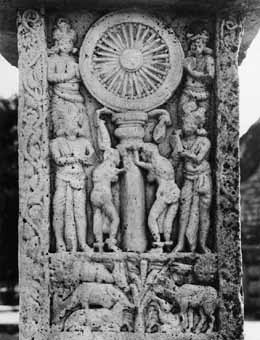
1950 - 1960
Embracing the Wheel of the Law
Increasingly ill with diabetes, and bitterly disappointed by the political behavior of Nehru and Congress, Dr. Ambedkar resigned from the Cabinet, and then left political life. In a huge ceremony at Nagpur, he became a convert to Buddhism; and within a few months he was dead.
Milestones
1950:
Dr.
Ambedkar gave several addresses about Buddhism; in May, he flew to Colombo [site],
in Sri Lanka, to pursue further Buddhist connections.
1951:
In February,
he introduced in Parliament the "Hindu Code Bill" that he had drafted,
which included greatly expanded rights for women; it proved very controversial,
and consideration of it was postponed: on the Hindu Code Bill (see #8). (K. N. Kadam, Dr. Babasaheb Ambedkar and the Significance of his Movement: A Chronology, Bombay: Popular Prakashan, 1991, pp. 121-22).
1951:
In September,
Dr. Ambedkar resigned from the Cabinet, embittered over the failure of Nehru
and the Congress to back the Hindu Code Bill as they had earlier pledged
to do. He became the Leader of the Opposition (see #9). Discussion: The
Hindu. (K. N. Kadam, Dr. Babasaheb Ambedkar and the Significance of his Movement: A Chronology, Bombay: Popular Prakashan, 1991, pp. 121-22).
1952:
Dr.
Ambedkar received an honorary L.L.D. degree from Columbia University as part
of its Bicentennial Special Convocation. The President described him as "one
of India's leading citizens--a great social reformer and a valiant upholder
of human rights."
1953:
His political
thinking included analysis of the issue of linguistic states; he published "Need
for Checks and Balances" (Times of India, April 23, 1953) on
this question. In 1955, he was still working on the subject, as the preface
(dated Dec. 23, 1955) to "Thoughts
on Linguistic States" testified.
1954:
In the
midst of his round of (increasingly embittered) Parliamentary and other
activity, his health gave way; he was confined to bed for two months.
1954:
While
dedicating a new Buddhist vihara near Poona, Dr. Ambedkar announced that he was
writing a book on Buddhism, and that as soon as it was finished, he planned to
make a formal conversion to Buddhism. He also claimed that the image of Vithoba
at Pandharpur [site] was in reality an image of the Buddha, and said that he would write
a thesis to prove this claim. (Dhananjay Keer, Dr. Ambedkar: Life and Mission,
Bombay: Popular Prakashan, 1971 [1954], p. 482.)
1956:
Dr. Ambedkar brought the manuscript of "The
Buddha and His Dhamma" to completion. "In February 1956 two new chapters
are added to it: 'There is no god'; 'There is no soul'....On March 15, 1956,
Ambedkar wrote the Preface to his book in his own handwriting and dictated
it to Rattu [his secretary]." Printing began in May, but was slowed by constant
last-minute revisions of the proofs. (Dhananjay Keer, Dr. Ambedkar:
Life and Mission, Bombay: Popular Prakashan, 1971 [1954], pp. 488-489,
491.)
1956:
From June
to October, he was bedridden in his Delhi residence. His eyes were failing,
he suffered from side effects of the drugs he was given for his diabetes,
he felt deeply depressed.
1956:
His formal conversion took place on Oct. 14th in Nagpur, a town selected for reasons
he explained in his moving speech, "Why
Was Nagpur Chosen?" Many thousands of Mahars and other Dalits accepted
Buddhism along with him.
1956:
In November,
he flew to Kathmandu to attend the Fourth World Buddhist Conference.
1956:
On Dec.
2, he completed the manuscript of "The
Buddha or Karl Marx," his last finished work, and gave it for typing.
1956:
On the
night of Dec. 5 or the early morning of Dec. 6, he died quietly in his sleep; on Dec. 7 there was a huge
Buddhist-style funeral procession in Bombay, and he was cremated on the seashore.
1957:
"The
Buddha and His Dhamma," Dr. Ambedkar's own version of a Buddhist scripture
for his people, was posthumously published, by Siddharth College Publications,
Bombay.
1957 and beyond:
A number of unfinished typescripts and handwritten drafts were found among
his notes and papers and gradually made available. Among these are "Waiting
for a Visa," which probably dates from 1935-36, and "Untouchables,
or the Children of India's Ghetto", which refers to the census of 1951
and so must be quite late; other unpublished fragments as well will be found
on the Ambedkar.org
website.